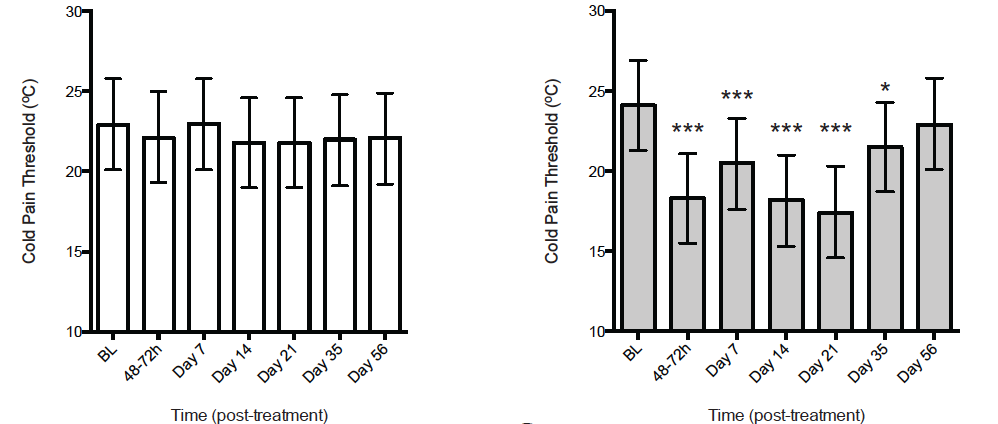Cryolipolysis is a non-invasive, skin cooling treatment for local fat reduction that causes prolonged hypoesthesia over the treated area. This clinical study shows that cryolipolysis causes significant and prolonged decreases in mechanical and thermal cutaneous sensitivity (QST), and epidermal nerve fiber density (histology), which persist for weeks in adult human volunteers.
These findings suggest that controlled skin cooling to specifically target cutaneous nerve fibers has the potential to be useful for therapies designed to provide prolonged relief of cutaneous pain.
A.Control (white) B.Treatment (gray)

Cryolipolysis reduces cutaneous sensitivity to mechanical and thermal sensitivity, including cold pain threshold. Sensory threshold for Control side is shown in white bars and Treatment side is shown in grey bars. Data for each side are compared with baseline (BL) sensory threshold. Bars represent mean; whiskers represent 95% CI; p-values determined from Mixed Model Repeated Measures ANOVA with Bonferroni correction (assuming significance at p<0.05).
Who was eligible to participate?
- Aged 18-65 years old
- Visible adiposity on both flanks
- No known neurologic disorders, cold sensitivity, allergy, or hypersensitivity to histamine
- No known dermatologic condition in the area to be treated
What did the study involve?
11 subjects were randomized to receive a single cryolipolysis treatment on with the left or right flank. Subjects were asked to take part in skin sensation testing and to have a skin biopsy. Subjects were enrolled in the trial for 6 weeks (clinicaltrials.gov: NCT01673113).
- Skin sensation testing (QST and histamine iontophoresis) involved measuring responses to touch, pressure, temperature and histamine-induced itch. We wanted to look at flank sensitivity to each type of sensation.
- Skin biopsies were collected and allowed us to look at changes nerve density over time.
Collaborating research groups
The study was conducted with our collaborators, Dr. Garibyan (lead author) and Professor Anderson (Principal Investigator), from the Wellman Center for Photomedicine, Massachusetts General Hospital.
Related publications
Garibyan L, Cornelissen L, Sipprell W, Pruessner J, Elmariah S, Luo T, Lerner EA, Jung Y, Evans C, Zurakowski D, Berde CB, Anderson RR. Transient Alterations of Cutaneous Sensory Nerve Function by Non-Invasive Cryolipolysis. J Invest Dermatol. 2015 Jun 22. doi: 10.1038/jid.2015.233. PubMed PMID: 26099028.